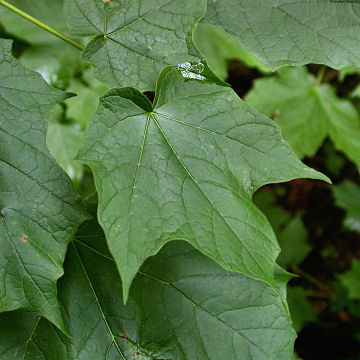

Acer nigrum - (image 1 of 6)
Taxonomy
Family: Aceraceae
Habitat
Rich to somewhat dry, calcareous woods. Tends to be found on moister sites than A. saccharum, often along streams or in ravines.
Associates
Distribution
New England south to VA and GA, west MN to AK.
Morphology
Similar to A. saccharum in many respects. Leaves dark green, pubescent below, 3-5 lobed; when 5 lobed the lower lobes usually less distinct than in A. saccharum; base of petiole often subtended by 2 foliaceous stipules. New growth pubescent. Twigs stout, mottled gray, with somewhat hairy buds. Bark usually darker than A. saccharum and more deeply furrowed.
Notes
Flowers late April to early May
Wetland Indicator: Upland
Closely related to A. saccharum and hybridization frequently occurs between these two species. One should look for a combination of characteristics since many of the ones listed above may be obscure or absent. At a distance the margin of the leaves of A. nigrum tend to droop, given them a slightly wilted appearance. In addition, Acer nigrum usually has stipules (tiny leaf-like structures) subtending the base of the petiole, the lower leaf surfaces and typically the petioles are pubescent. This species seems to prefer moister and more calcareous habitats than A. saccharum. Fall color typically yellow.
Most common in the Midwest, where this species may have been the principle source of maple sugar prior to European settlement (Swink & Wilhelm 1994).
References
Gleason, Henry A.
and A. Cronquist. 1991. Manual of Vascular Plants of Northeastern United States
and Adjacent Canada. Second Ed.
The New York Botanical Garden. Bronx, NY
Hardin, J.W., D. J. Leopold, and F.M. White. 2000. Harlow and Harrar’s Textbook of Dendrology. Ninth Ed.
McGraw-Hill. New York.
Swink, F. and G.
Wilhelm. 1994. Plants of the Chicago Region.
Indiana Academy of Science. The Morton Arboretum. Lisle, Illinois.
USDA, NRCS. 2002. The PLANTS Database, Version 3.5 (http://plants.usda.gov).
National Plant Data Center, Baton Rouge, LA 70874-4490 USA.
|
© Michael Hough 2009 |